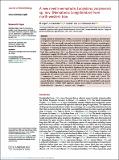Por favor, use este identificador para citar o enlazar a este item:
http://hdl.handle.net/10261/340548COMPARTIR / EXPORTAR:
 SHARE SHARE
 CORE
BASE CORE
BASE
|
|
| Visualizar otros formatos: MARC | Dublin Core | RDF | ORE | MODS | METS | DIDL | DATACITE | |

| Título: | A new needle nematode, Longidorus zanjanensis sp. nov. (Nematoda: Longidoridae) from north-western Iran |
Autor: | Asgari, Mohsen; Eskandari, Ali; Castillo, Pablo CSIC ORCID ; Palomares Rius, Juan E. CSIC ORCID | Palabras clave: | Taxonomy Astragalus sp. Zanjan New species Phylogeny |
Fecha de publicación: | 7-nov-2023 | Editor: | Cambridge University Press | Citación: | Journal of Helminthology 97: e81 (2023) | Resumen: | During a survey of soil nematodes in 2022, a new species of the genus Longidorus, described here as Longidorus zanjanensis sp. nov., was discovered in the rhizosphere of Astragalus sp. in Zanjan Province, Iran. The new needle nematode is described and illustrated based on morphological, morphometric, and molecular traits. Further, its females are characterized by having a long body ranging 5.6-7.7 mm long, lip region anteriorly flattened and almost continuous or slightly offset by a depression with body contour, ca 16.5-18.5 μm wide, amphidial fovea pouch-like without basal lobes, guiding ring at 35-41 μm distance from the anterior end, and an odontostyle and odontophore ranging 102-115 and 47-75 μm long, respectively. The pharyngeal bulb is 123-153 μm long, female reproductive system didelphic-amphidelphic containing sperm, vulva almost equatorial, located at 46.7-51.4% of body length, tail short, rounded to bluntly conoid, bearing two pairs of caudal pores and terminus widely rounded with distinct radial lines in hyaline region (39-50 μm long, c = 122.4-189.4, c' = 0.6-0.8). Males are common, making up to 60% of the adults, and are functional, with spicules 68.0-80.0 μm long, as well as having 8-14 ventromedian copulatory supplements. All four juvenile life developmental stages were present, with the tail of first-stage juvenile conoid shape, dorso-ventrally curved with rounded terminus. The polytomous codes delimiting the new species are: A4-B3-C3-D3-E1-F34-G12-H1-I2-J1-K6. Morphologically, the new species comes close to eight known species of the genus, namely L. apulus, L. armeniacae, L. crassus, L. kheirii, L. soosanae, L. proximus, L. pauli, and L. ferrisi. The morphological differences between the new species and the aforementioned species are discussed. Molecular phylogenetic analyses based on D2-D3 of large subunit (LSU) and internal transcribed spacer 1 (ITS1) rRNA sequences indicate that Longidorus zanjanensis sp. nov. is closely related to L. hyrcanus, L. soosanae, and L. elongatus. | Versión del editor: | https://doi.org/10.1017/S0022149X23000664 | URI: | http://hdl.handle.net/10261/340548 | DOI: | 10.1017/S0022149X23000664 | ISSN: | 0022-149X | E-ISSN: | 1475-2697 |
| Aparece en las colecciones: | (IAS) Artículos |
Ficheros en este ítem:
| Fichero | Descripción | Tamaño | Formato | |
|---|---|---|---|---|
| J_Helminthology-97_e81_1-12.pdf | 4,66 MB | Adobe PDF |  Visualizar/Abrir |
CORE Recommender
Page view(s)
16
checked on 29-abr-2024
Download(s)
10
checked on 29-abr-2024
Google ScholarTM
Check
Altmetric
Altmetric
Este item está licenciado bajo una Licencia Creative Commons

